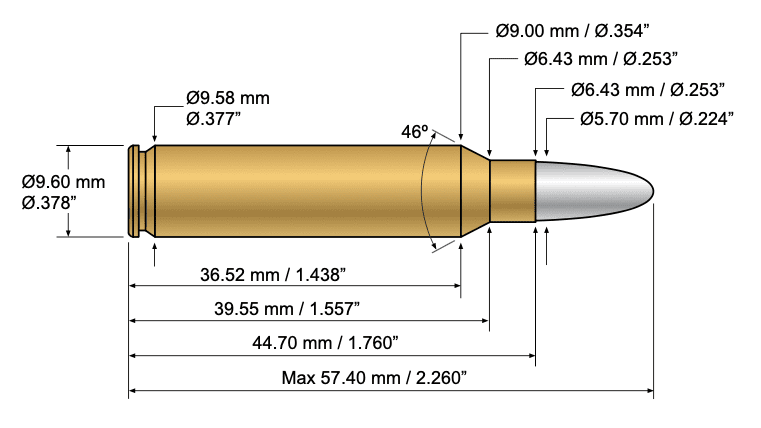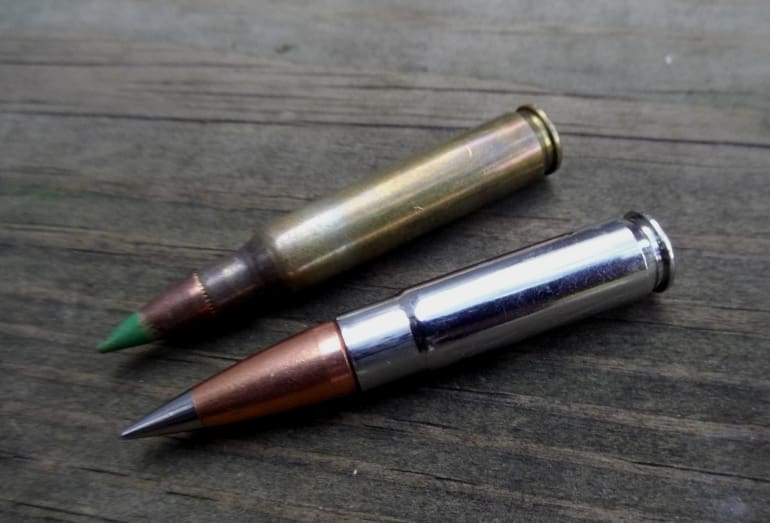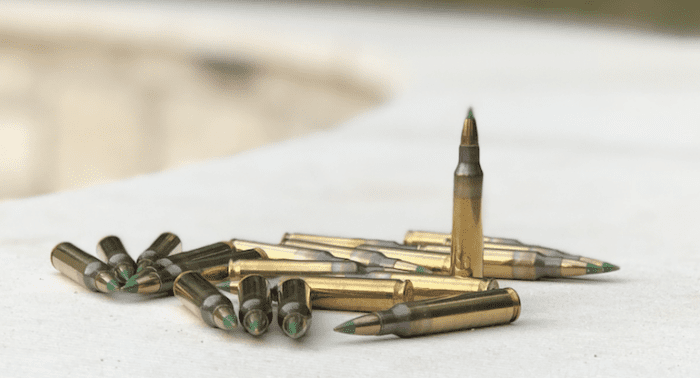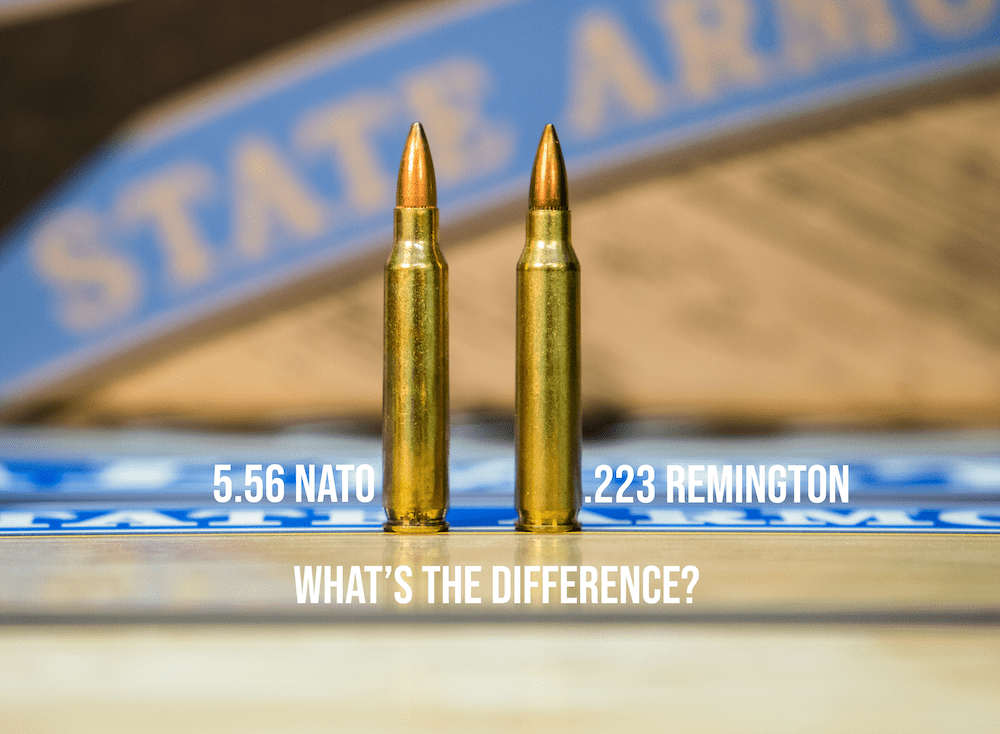The 5.56×45mm NATO standard SS109/M855 cartridge was designed for maximum performance when fired from a 508 mm (20.0 in) long barrel, as was the original 5.56 mm M193 cartridge. Experiments with longer length barrels up to 610 mm (24.0 in) resulted in no improvement or a decrease in muzzle velocities for the SS109/M855 cartridge. Unless the gas port can be regulated or adjusted for higher pressures, suppressors for short barreled 5.56×45mm NATO firearms must be larger and heavier than models for standard length rifles to function reliably. Since its introduction, the M855A1 has been criticized for its St. Mark's SMP842 propellant causing increased fouling of the gun barrel.
Post-combat surveys have reported no issues with the EPR in combat. A series of tests found no significant difference in fouling between the old M855 and the M855A1. However, manufacturers have reported "severe degradation" to barrels of their rifles using the M855A1 in tests. The Army attributes pressure and wear issues with the M855A1 to problems with the primer, which they claim to have addressed with a newly designed primer.
During Army carbine testing, the round caused "accelerated bolt wear" from higher chamber pressure and increased bore temperatures. Special Operator testing saw cracks appear on locking lugs and bolts at cam pin holes on average at 6,000 rounds, but sometimes as few as 3,000 rounds during intense automatic firing. Firing several thousand rounds with such high chamber pressures can lead to degraded accuracy over time as parts wear out; these effects can be mitigated through a round counter to keep track of part service life. If the 5.56 mm bullet is moving too slowly to reliably yaw, expand, or fragment on impact, the wound size and potential to incapacitate a person is greatly reduced. Others, like the 6.5mm Grendel (6.5×39mm), are attempts at engineering an all purpose cartridge that could replace both the 5.56 and 7.62 NATO rounds. All these cartridges have certain advantages over the 5.56×45mm NATO, but they have their own individual tradeoffs to include lower muzzle velocity and less range.
Additionally, when using a round not based on the case of the 5.56 there can be decreased magazine capacity, and different internal parts. None of these cartridges have gained any significant traction beyond sport shooting communities. For short-range trajectory, we are going to compare our selected rounds out to a distance of 300 yards with the test firearms zeroed in at 100 yards. Data was generated by compiling the numbers from the manufacturer or by a ballistics calculator. With the ballistics calculator, we determined the short range trajectory by using each rounds bullet weight, muzzle velocity, and ballistic coefficient . The 5.56mm NATO chamber, known as a NATO or mil-spec chamber, has a longer leade, which is the distance between the mouth of the cartridge and the point at which the rifling engages the bullet.
The .223 Remington chamber, known as SAAMI chamber, is allowed to have a shorter leade, and is only required to be proof tested to the lower SAAMI chamber pressure. To address these issues, various proprietary chambers exist, such as the Wylde chamber or the ArmaLite chamber, which are designed to handle both 5.56×45mm NATO and .223 Remington equally well. The leade of the .223 Remington minimum C.I.P. chamber also differs from the 5.56mm NATO chamber specification. The 5.56 shoots flatter, faster, and has a lower recoil impulse with higher BC bullets. However, because it is shooting a bullet between 55 and 77 grains, it relies on velocity to be effective. The M855 stuff for example requires 2700 fps to reliably fragment and hardly ever fragments below 2500 fps.
This means that even from the 20 inch barrel of an M16, you're looking at an effective range below 250 yards. You can hit beyond that range, but whether the round is going to be effective is debatable. The Mk 262 Mod I reportedly brings this velocity threshold down to about 22 fps, extending the range, but still not offering much over the 7.62x39. And here's why; the 7.62x39 may not have the best external ballistics, but it relies more on mass and diameter to be effective. At 300 yards your typical 125 gr load from an AK is still going to have the velocity, energy, mass, and momentum of the .357 Magnum at the muzzle.
It beats many premium +P defensive rounds for the 9mm at 400. Hitting may be more difficult, but adjusting for bullet drop merely requires practice. And any difficulty experienced is only due to a lack of RCO-like optics to provide BDC for the 7.62x39. The 5.56 NATO is a fine round, it generally uses bullets in the 55-69gr. The velocity, and with it terminal performance, can drop off significantly in short barreled carbines - this eventually led to the development of the 6.8 SPC and 6.8 SPC spec.
In 1961, marksmanship testing compared the AR-15 and M-14; 43% of ArmaLite AR-15 shooters achieved Expert, while only 22% of M-14 rifle shooters did. In July 1962, operational testing ended with a recommendation for adoption of the ArmaLite AR-15 rifle chambered in .223 Remington. In September 1963, the .223 Remington cartridge was officially accepted and named "Cartridge, 5.56 mm ball, M193". The following year, the ArmaLite AR-15 was adopted by the United States Army as the M16 rifle and it would later become the standard U.S. military rifle. The specification included a Remington-designed bullet and the use of IMR4475 powder, which resulted in a muzzle velocity of 3,250 ft/s and a chamber pressure of 52,000 psi.
In 1999, SOCOM requested Black Hills Ammunition to develop ammunition for the Mk 12 SPR that SOCOM was designing. The problems were addressed with a slower burning powder with a different pressure for use in the barrel, creating the Mk 262 Mod 1 in 2003. During the product improvement stage, the new propellant was found to be more sensitive to heat in weapon chambers during rapid firings, resulting in increased pressures and failure to extract. This was addressed with another powder blend with higher heat tolerance and improved brass. Also during the stage, Black Hills wanted the bullet to be given a cannelure, which had been previously rejected for fear it would affect accuracy.
It was eventually added for effective crimping to ensure that the projectile would not move back into the case and cause a malfunction during auto-load feeding. Although the temperature sensitive powder and new bullet changed specifications, the designation remained as the Mod 1. But at the end of the day with 7.62x39mm, even if you have a rock-solid load and platform, you have moderate energy pushing a low-BC bullet. It would take a lot of correction to sight in past a few hundred meters. Shooting off hand, in hunting or a practical application, where your target may present itself at 50m or 400m, you're not going to be able to reliably account for the bullet curve and be accurate from too far away.
The 7.62x39mm does what it was designed to do, and if people can tune them to give good groups off sandbags after sighting in for 15 minutes, power to them. Let's take a look at the recoil energy that is generated from our ten selected rounds and see if this trend holds up or if we see a little more variability. This data was generated using each rounds bullet weight, muzzle velocity, gun weight , and the powder charge. For the powder charge, we averaged several common powder loads from Nosler's load data and kept that charge constant for each round of the same cartridge.
These numbers might fluctuate slightly depending on the actual powder charge used by the manufacturer, but the trends between the cartridges should remain . Similar to the 5.56, the 223 covers a long distance when fired from the gun's barrel. The bullet starts losing altitude and velocity with time reducing the impact that the bullet has when it finally reaches the target. This makes it perfect for shooting game in the woods without getting too near. Controversy covers the use of the 223 in civilian hands due to its ability to drop long-range targets with high accuracy.
It is, however, marked safe for use in civilian hands. The U.S. military had adopted for limited issue a 77-grain (5.0 g) "Match" bullet, type classified as the Mk 262. The heavy, lightly constructed bullet fragments more violently at short range and also has a longer fragmentation range. Originally designed for use in the Mk 12 SPR, the ammunition has found favor with special forces units who were seeking a more effective cartridge to fire from their M4A1 carbines. Commercially available loadings using these heavier bullets can be prohibitively expensive and cost much more than military surplus ammunition.
Additionally, these heavy-for-caliber loadings sacrifice some penetrative ability compared to the M855 round . Performance of 5.56×45mm military ammunition can generally be categorized as almost entirely dependent upon velocity in order to wound effectively. Heavy OTM bullets enhance soft tissue wounding ability at the expense of hard-target/barrier penetration. Similar intermediate cartridges were developed and adopted by the Soviet Union in 1974 (5.45×39mm) and by the People's Republic of China in 1987 (5.8×42mm).
From our experience and research, the 7.62x39mm offers a lot more options when it comes to hunting more medium sized game. The increase in bullet energy for these rounds within 100 yards is much better suited for medium sized game. For shots within 100 yards, you have a fair shot at good bullet placement, and with the stopping power of the heavier bullets, you should be able to make a clean kill. These same regions also make it a popular cartridge for close quarters combat. If you pair the correct bullet design, you can easily punch through cover with this cartridge with power to spare. I have a 10.5 inch pistol and a 14.5 inch barrel rifle.
It takes a minimal mount of tweaking to get them cycling perfect but then it is awesome. There is plenty of inexpensive ammo and there is hunting rounds. I have shot holes through 1/4 inch steel at 100 yards and I have read that many white tail and large hogs have been taken with this caliber.
I would want a heavier grain 30 caliber type rifle for my general purpose and a great SHTF rifle. An AR15 running 7.62x39 is exactly what Colonel Jeff Cooper was talking about for an ideal scout style rifle. The real difference between 5.56 and .223 isn't the cartridges, but the chambers and barrels of the guns firing these two cartridges.
Remember those reliability issues the M16 suffered in Vietnam? When the rifle got dirty and gunked up, tight tolerances made chambering rounds and cycling the weapon difficult. The Army also wanted a more powerful round that could better penetrate light steel and enemy combat helmets. To address reliability concerns and to "juice up" the .223 Remington for battle, engineers redesigned the M16's chamber. They made the leade of the chamber slightly larger, so it wouldn't bind up in battlefield conditions. The larger chamber also allowed for more pressure to build safely, increasing velocity and penetration at distance.
The maximum effective point target range of an M4 carbine with M855 rounds is 500 m , with a maximum effective area target range of 600 m . These mark the greatest distances the rounds can be expected to accurately hit the target, not the ranges that they have terminal effectiveness against them. Because the M855 is yaw dependent it requires instability in flight to deform upon hitting the target. It is the most stable in flight between 150–350 m (164–383 yd), potentially lessening its effectiveness if it strikes an enemy between those distances. In addition to this, tests have shown that 5.56 mm bullets fragment most reliably when traveling faster than 2,500 ft/s (760 m/s).
From full-length 20 in rifle and machine gun barrels, rounds exhibit velocities above 2,500 ft/s (760 m/s) out to 200 m . An M855 fired from a shorter barreled M4 carbine exhibits a bullet velocity of 2,522 ft/s (769 m/s) at 150 m range. Even if it impacts at optimum speeds, 70 percent of 5.56 mm bullets will not begin to yaw until 4.7 in of tissue penetration. 15 percent more begin to yaw after that distance, so up to 85 percent of rounds that hit do not start to fragment until nearly 5 in of penetration.
Against small statured or thin combatants, the M855 has little chance of yawing before passing through cleanly and leaving a wound cavity no bigger than the bullet itself. The factors of impact angle and velocity, instability distance, and penetration before yaw reduce the round's predictable effectiveness considerably in combat situations. By observation, 5.56×45mm NATO ammunition is not as accurate as .223 Remington in many of the AR type rifles extant, even with the same bullet weight. It was designed to increase the accuracy of 5.56×45mm NATO ammunition to that of .223 Remington.
Other companies also have chamber designs that increase 5.56×45mm NATO accuracy. The .223 Remington and 5.56×45mm NATO barrel chamberings are not the same. While the cartridges are identical other than powder load, bullet weight, and chamber pressure, a significant difference is in barrel of the rifle to be used, not in the cartridge. The 5.56×45mm NATO chambers are dimensionally larger in certain critical areas than .223 Remington chambers. As the chambers differ accordingly the head space gauges used for the two chamberings differ. Like the short range trajectory, we again see a significant difference between cartridges with each round grouping tightly with their cartridge type.
Even out to 300 yards there is a 15" difference in the average bullet drop favoring the 5.56 NATO. As the range increases so does the difference between the two cartridges. Out at 500 yards, there is at most 50″ of difference between the two. The 5.56 NATO rounds lose between 40-50″ while the 7.62×39 rounds drop ″. This is a significant bullet drop for both rounds, but the 7.62×39 is much more pronounced and will be a major factor in applications for these two cartridges. The 223 Remington bullet is lighter and has less pressure in its chamber.
Comparing the stopping power of the two bullets when fired from a 5.56 barrel means reviewing the impact of the velocity at which the bullet is travelling at when it stops. Leaving the guns' barrel at the same speed will see the heavier 5.56 bullet drop faster than the 223. The 5.56 also maintains the higher velocity for longer, thus implying that the 5.56 velocity has a greater stopping power as compared to the 223 velocity. The 7.62x39mm flies faster, which usually translates to a greater maximum effective range. This 123-grain Fusion load from Federal exits the barrel at 2,300 fps and requires a velocity of 1,600 fps to reliably expand.
The bullet remains above that velocity out to 275 yards but by that time has dropped about 20 inches. Your ability to take game confidently depends on your rifle's accuracy, but that's a big drop for that distance, so we recommend keeping shots within 200 yards. By contrast, most civilians must make each shot count. In any civilian application short of a total apocalypse, a civilian is going to be held accountable for every round they fire. It's about doing more with less and making each shot count.
This is possible because with modern ammunition, the 7.62 is much more effective than anything that can be loaded in a 5.56. A civilian can stockpile as much ammo as they feel they need and in most situations be confident they won't have to displace with it. Even when moving, enough ammo can be carried to make it through any situation likely to be encountered short of alien zombies. Using 5.56×45mm NATO mil-spec cartridges in a .223 Remington chambered rifle can lead to excessive wear and stress on the rifle and even be unsafe, and SAAMI recommends against the practice. The Belgian 62 gr SS109 round was chosen for standardization as the second NATO standard rifle cartridge which led to the October 1980 STANAG 4172. An actual helmet was not used for developmental testing, but an SAE 1010 or SAE 1020 mild steel plate, positioned to be struck at exactly 90 degrees.
It had a slightly lower muzzle velocity but better long-range performance due to higher sectional density and a superior drag coefficient. This requirement made the SS109 round less capable of fragmentation than the M193. When we look at the trajectory, especially out past 200 yards, the 5.56 is much flatter than the 7.62×39 rounds. While the stopping power is significantly different, we are just sticking with accuracy, and less bullet drop is going to make putting a bullet on target all the easier. Velocity is a vital comparison category because it is linked to all ballistic and performance specifications of both cartridges.
Faster cartridges hit the target quicker, and they're less prone to the surrounding factors that can distort the flight path and trajectory of a bullet. Velocity is also important in terminal ballistics, particularly for increasing the size and penetration power of the bullet. The 5.56x45 cartridge is not only popular in the military, but also in the civilian circles where the AR-15 is usually chambered for these cartridges.
The ammunition is readily available and it has varying bullet weights and designs to suit the needs of the user. For reloading the bullets all by yourself, don't forget to check out the best reloading press reviews. The NATO military alliance uses a NATO-specific recognized class of procedures to control the safety and quality of firearms ammunition called NATO EPVAT testing.
The civilian organisations C.I.P. and SAAMI use less comprehensive test procedures than NATO. Over pressure of 25% means 25% in excess of the service pressure resulting for the 5.56×45mm NATO up to 430.0 MPa piezo service pressure. The service pressure is defined as the mean pressure generated by the service cartridge at a temperature of 21 °C (70 °F).


























